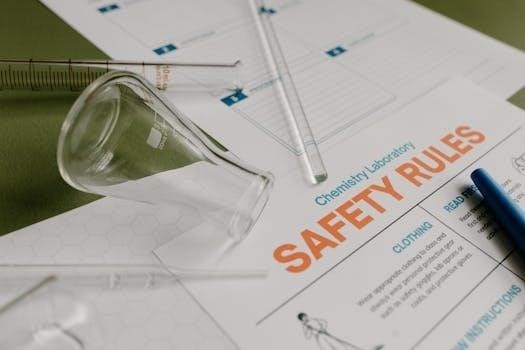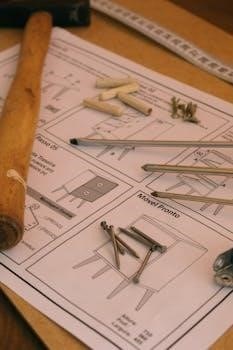Accurate corset measuring is crucial for achieving the perfect fit, ensuring comfort and enhancing your silhouette․ This process involves taking precise body measurements to select the correct corset size and style, which is essential for achieving the desired waist reduction and overall aesthetic․
Importance of Accurate Measurements
Accurate measurements are paramount when selecting a corset, as they directly influence the garment’s fit, comfort, and effectiveness․ Incorrect measurements can lead to discomfort, improper shaping, and even damage to the corset․ A corset that is too small might restrict movement and cause pain, while one that is too large will not provide the desired waist reduction or support․ Therefore, meticulous measuring ensures that the corset sits correctly on your body, distributing pressure evenly and achieving the intended silhouette․ Furthermore, precise measurements enable you to choose the appropriate style and length for your body type, ensuring optimal comfort and a flattering look․ Taking the time to measure accurately will save you from potential issues and ensure you are selecting the best fitting corset for your individual needs․ Always double check your measurements for accuracy․

Essential Measuring Tools
The primary tool needed for corset measuring is a flexible measuring tape․ A full-length mirror can also assist in ensuring the tape is positioned correctly and parallel to the ground during measurement․
Measuring Tape
A flexible measuring tape is the most essential tool for accurately measuring your body for a corset․ Ensure the tape is not stretched or twisted, as this can lead to inaccurate readings․ The tape should be snug against your skin but not so tight that it indents your flesh․ For accurate results, always measure two to three times․ It’s also crucial to maintain a parallel position with the floor while taking measurements․ When using the tape, it is important that you do not slouch or extend your body, but rather keep a relaxed and neutral posture․ Do not suck in your stomach, as it will give an inaccurate measurement; Always note each measurement you take․ You can also download a measuring tape if you don’t have one, for extra convenience․ This will help you get the best corset fit․

Key Body Measurements for Corsets
To get the best corset fit, several key body measurements are necessary, including the underbust, waist, upper hip, and lower hip․ These measurements ensure the corset fits correctly and provides the desired silhouette․
Underbust Measurement
The underbust measurement is taken directly beneath the bust, where your bra band sits․ Ensure that the measuring tape is parallel to the ground and snug, but not too tight․ This measurement is crucial as it determines the upper edge of an underbust corset and the overall fit around the ribcage․ It’s essential to measure at your bra line, keeping the tape level and relaxed․ This measurement helps ensure that the corset is not too restrictive around the ribcage, allowing for comfortable wear․ Remember to measure 2-3 times for accuracy․ This measurement is a key factor in determining the correct corset size, and how it will fit on your body․ The underbust is a foundational measurement for proper corset fitting․ It is important that this measurement is precise․
Waist Measurement
The waist measurement is taken at the narrowest point of your torso, typically located just above the belly button․ It’s crucial to stand relaxed and avoid sucking in your stomach during this measurement, as this can lead to an inaccurate reading․ Ensure the measuring tape is snug around your waist but not tight, and that it remains parallel to the ground․ This measurement is fundamental for determining your corset size, as most corsets are sized based on their waist circumference․ This measurement is critical for the corset to fit properly and achieve the desired silhouette and waist reduction․ Record the measurement carefully, as it will be used to choose the right corset size․ This measurement is the most important for selecting the correct corset․
Upper Hip Measurement
The upper hip measurement is typically taken approximately four inches below your natural waistline․ This measurement is essential for ensuring the corset provides a comfortable and flattering fit, especially for styles that extend over the hips․ To locate the correct point, measure down from your waistline and ensure the measuring tape is parallel to the floor․ This measurement helps determine how the corset will sit on your hips and is key to avoiding any discomfort or restriction of movement․ It is important that the tape is snug, but not too tight, for an accurate reading․ This measurement is especially important for corsets that have a hip spring or flare, as the correct measurement will ensure the corset doesn’t dig or pinch at the hips․
Lower Hip Measurement
The lower hip measurement is usually taken approximately six inches below your natural waistline, or at the top of your pubic triangle․ This measurement is vital for determining the fit of longer corsets, ensuring the lower edge of the corset sits comfortably on your body․ To accurately measure, position the tape measure around the fullest part of your lower hips, keeping it parallel to the floor and snug against your skin, but not too tight․ This measurement is crucial for ensuring the corset doesn’t restrict movement or cause discomfort around the lower hip area․ It’s important to remember that this measurement may not be necessary for all corset styles, but is vital for longer corsets, or those with a more significant hip spring, to ensure a proper, comfortable fit without any digging or pressure points․ The correct low hip measurement ensures the corset will lay smoothly․
Corset Size Selection
Choosing the right corset size involves considering your natural waist measurement and desired waist reduction․ Corset sizes are typically smaller than your natural waist to achieve the cinched effect, and understanding this is key․
Choosing the Correct Size Reduction
Selecting the appropriate size reduction is crucial for comfort and achieving the desired silhouette․ Typically, a corset is chosen 3 to 7 inches smaller than your natural waist, depending on your body’s “squishiness” or muscle density․ Those with more soft tissue may comfortably achieve a greater reduction, while individuals with more muscle may need a smaller reduction․ It’s important to consider the type of corset as well, with waist training corsets often requiring a more significant reduction than fashion corsets․ A smaller reduction is better for those new to corsets․ Always ensure the corset feels comfortable, even when fully closed․ If you are tiny your waist will not compress as easily․ It is recommended to seek a sizing consultation from experts, if possible, who can assess your measurements and help you choose the correct corset size for your body and desired effect, and refer to sizing charts for specific models․

Corset Fit and Body Shape
Corset fitting isn’t just about size; it’s about considering your unique body shape and proportions․ Different corset styles cater to various body types, ensuring a flattering and comfortable fit․ Selecting a suitable style helps achieve the desired silhouette․
Considering Body Shape and Proportions
When choosing a corset, it’s essential to consider your body’s unique shape and proportions, as this will impact how the corset fits and feels․ A conical corset, for instance, might not be suitable for those with a larger bust, as it could cause spillage․ Different corset shapes, such as underbust, overbust, and waspie styles, are designed to complement various body types․ Understanding whether you have a long or short torso, a high or low hip, and the distribution of your weight is crucial in selecting the most appropriate corset․ Some corsets are better suited for those with more “squish,” while others may work better for muscular builds․ The goal is to find a corset that not only reduces your waist but also enhances your natural curves and provides the necessary support․ Taking the time to understand your individual body shape will lead to a more comfortable and flattering corset experience․ It’s not just about size, but also about finding the right style and fit for your unique figure․

Additional Corset Specifications
Corset specifications, including length and spring, play a vital role in achieving the perfect fit․ These measurements determine the corset’s coverage and the amount of shaping it provides to the wearer․
Corset Lengths and Spring
Corset lengths vary significantly, impacting the overall look and functionality․ The front (busk) length, side length, and back length determine how much of the torso the corset covers․ Shorter corsets, such as cinchers and wasp waist styles, offer more freedom of movement but less support, while longer corsets provide greater posture correction and a smoother line under clothing but may restrict bending․
The rib and hip spring are also critical specifications․ Spring refers to the difference between the corset’s waist measurement and the measurements at the rib and hip points․ These springs are essential for accommodating the natural curves of the body and ensuring a comfortable, well-fitting corset․ Different corset styles have different spring measurements to accommodate the diversity of body shapes, some corsets having a larger hip spring and smaller rib spring, and others the opposite․
Torso length is another important consideration, as it indicates the suitable length of the corset for the wearer․ It is essential to consider these specifications when choosing the right corset for your body type and desired outcome․